Harnessing solar energy has become increasingly popular as a sustainable and renewable source of power. Solar panels are a key component of any solar power system, but they need a reliable companion to convert the DC (direct current) electricity they generate into the AC (alternating current) electricity that powers our homes and businesses. This is where solar inverters come into play. Solar inverters play a crucial role in the efficiency and effectiveness of a solar energy system.
In this blog, we will explore the different types of solar inverters and their unique features.
Inverters at a Glance
1. Grid-Tied: Making Connections
Also known as On-grid inverters, connect your solar system directly to the grid. They are perfect for reducing electricity bills and contributing surplus energy back to the grid for credits.
- Direct Grid Connection: Grid-tied inverters allow surplus energy to be fed back into the grid for net metering or to earn credits from your utility provider.
- Cost Savings: They are cost-effective and ideal for reducing electricity bills while benefiting the environment.
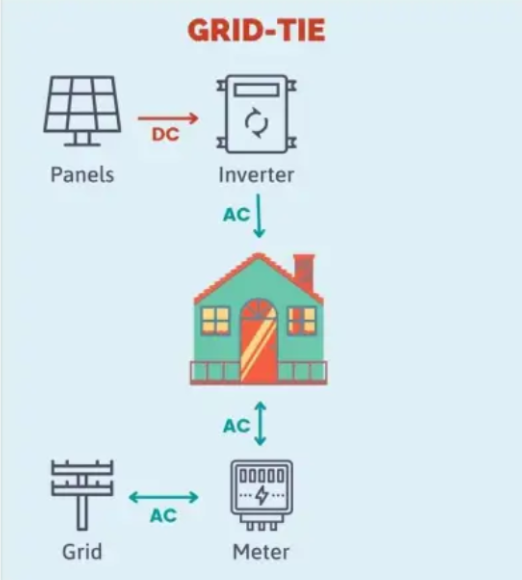
On – Grid Inverter
Link : https://habitatpoint.com/blog/designing-your-home-solar-power-system-off-grid-grid-tied-or-hybrid/
There are two main type of on grid inverters :
- String Inverters: Tying it All Together
String inverters connect multiple solar panels in a series, ensuring cost-effectiveness and reliability.
- Traditional and Reliable: String inverters are among the most common and traditional types of solar inverters. They are cost-effective and reliable.
- String Configuration: Multiple solar panels are connected in a series, or “string,” to a single string inverter.
- Output Limitations: The efficiency of the entire string is limited by the lowest-performing panel, so if one panel is shaded or damaged, it affects the entire string.

Structure of String Inverter
Link : https://greenridgesolar.com/types-of-solar-inverters/
- Central Inverters: Powering the Big Players
For large-scale applications, central inverters are the go-to choice. These robust devices are used in utility-scale solar installations and major commercial projects, ensuring efficiency and cost-effectiveness for massive arrays.
- Large-Scale Systems: Central inverters are typically used in utility-scale solar installations and large commercial projects.
- Efficiency and Cost-Effectiveness: They are highly efficient and cost-effective for large arrays but are not suitable for residential systems.
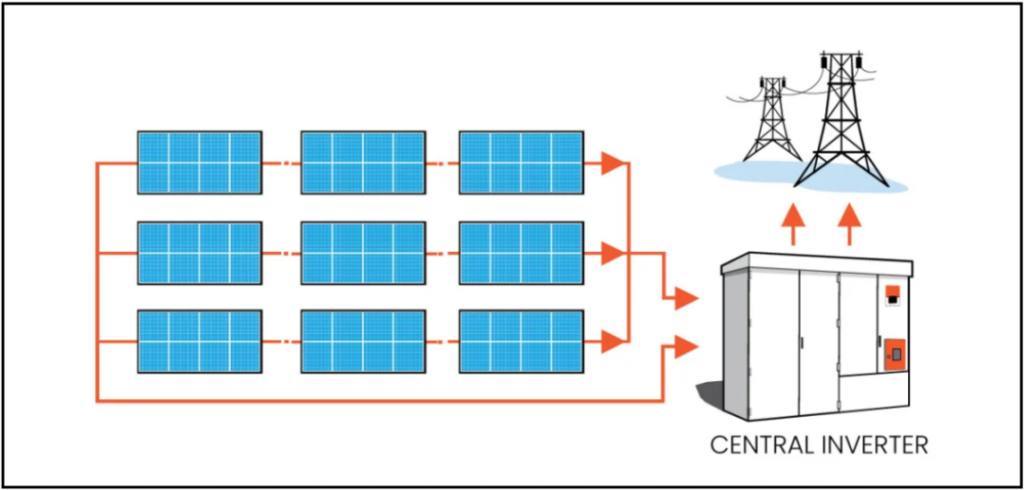
Structure of Central Inverter
Link : https://sinovoltaics.com/learning-center/inverters/central-inverters/
2. Off-Grid Inverters :
Off-grid inverters, on the other hand, enable standalone solar systems, crucial for remote cabins or islands where grid connection isn’t an option.
- Stand-Alone Systems: Off-grid inverters are essential for systems that are not connected to the utility grid, such as remote cabins or islands.
- Battery Storage: They work in conjunction with batteries to store excess energy for use during periods of low or no sunlight.

Off Grid Solar inverter
Link : https://www.xindun-power.com/faq/difference-between-off-grid-on-grid-and-hybrid-inverter.html
3. Hybrid Inverters: Energizing the Future
Hybrid inverters are designed for solar energy systems with energy storage, offering the ability to store surplus energy for later use. They can work in both off-grid and grid-tied configurations, although installation may be more complex.
- Storage Integration: Hybrid inverters are designed for use with solar batteries, allowing you to store excess energy for later use.
- Grid Interaction: They can work in off-grid or grid-tied modes, offering versatility for various applications.
- Complex Installation: Hybrid inverters are more complex to install and may require professional assistance.
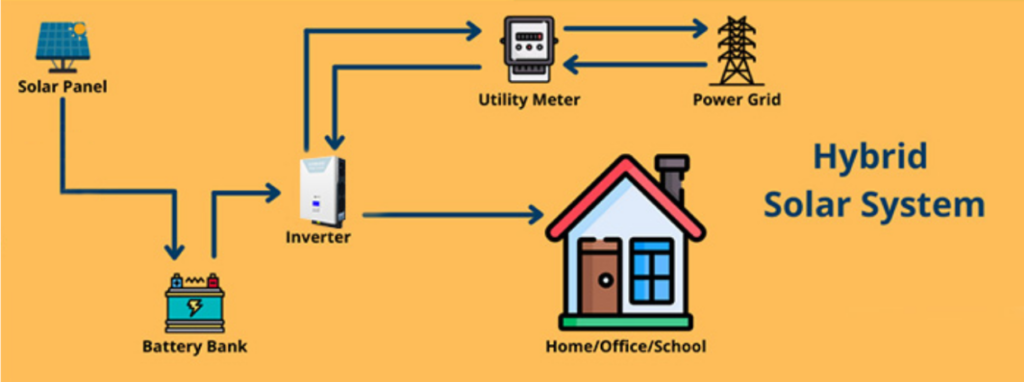
Hybrid Solar System
Link : https://www.xindun-power.com/faq/difference-between-off-grid-on-grid-and-hybrid-inverter.html
4. Module-Level Power Electronic Devices
Module-Level Power Electronic Devices (MLPEDs) are components installed at the level of individual solar panels in photovoltaic (PV) systems. They serve to optimize the performance of each panel and enhance the overall efficiency of the solar array.
- Enhanced Energy: MLPEDs maximize the energy output of each solar panel by optimizing its performance, even in challenging conditions like shading or varying panel orientations.
- Improved Safety: Some MLPEDs, like microinverters, offer rapid shutdown capabilities, enhancing safety during maintenance or emergencies by reducing the risk of electrical hazards.
- Cost: MLPEDs can be more expensive than traditional string inverters, particularly in large-scale installations where the cost per unit adds up.
There are primarily two types of module level devices :
- Microinverters: Fine-Tuning Efficiency:
Microinverters take a different approach by converting DC to AC at the panel level. This results in better performance, even when some panels are affected by shading or damage.
- Individual Panel Control: Microinverters are attached to each solar panel, converting DC to AC at the panel level.
- Optimized Performance: Microinverters maximize efficiency since each panel operates independently, reducing the impact of shading or damage to one panel.
- Higher Initial Cost: Microinverters can be more expensive upfront compared to string inverters.

Structure of Micro Inverter
Link : https://greenridgesolar.com/types-of-solar-inverters/
- Power Optimizers :
By mitigating shading, preventing clipping, and decreasing mismatch loss, power optimizers help get more energy from each panel while allowing panel level monitoring for more control and flexibility.
- Panel-Level Control: Power optimizers are similar to microinverters in that they allow for panel-level optimization.
- String Inverter Compatibility: They are often used in combination with string inverters to overcome shading and panel mismatch issues.
- Improved Efficiency: Power optimizers can enhance the efficiency of a string inverter setup while being more cost-effective than microinverters.
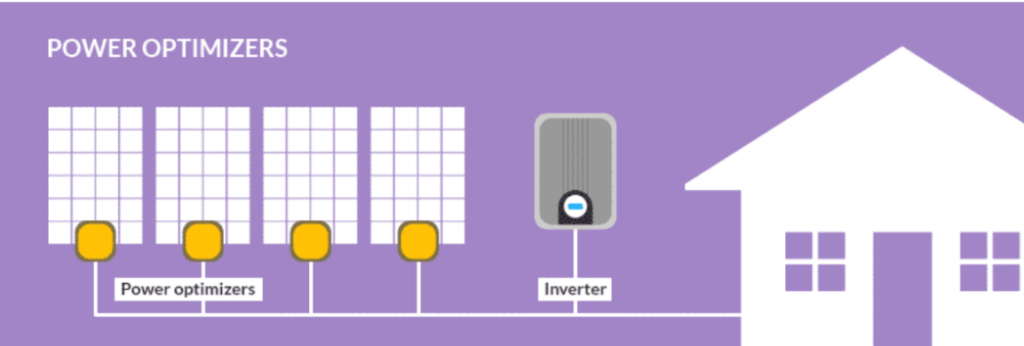
Structure of Power Optimizers
Link : https://greenridgesolar.com/types-of-solar-inverters/
Conclusion
In the world of solar energy, the inverter plays a vital role in converting and managing the power generated by solar panels. The choice of inverter depends on your specific needs, whether you’re aiming for efficiency, considering energy storage, or operating on a large scale. Whether it’s string, micro, or any other inverter, selecting the right type of inverter is key to harnessing the sun’s energy effectively and achieving your solar energy goals.
So, embark on your solar journey, knowing that the perfect inverter awaits to power your sustainable future.
Join our SafEarth marketplace to explore your options and buy your solar system from qualified installers in your area to make the switch easy and hassle-free.

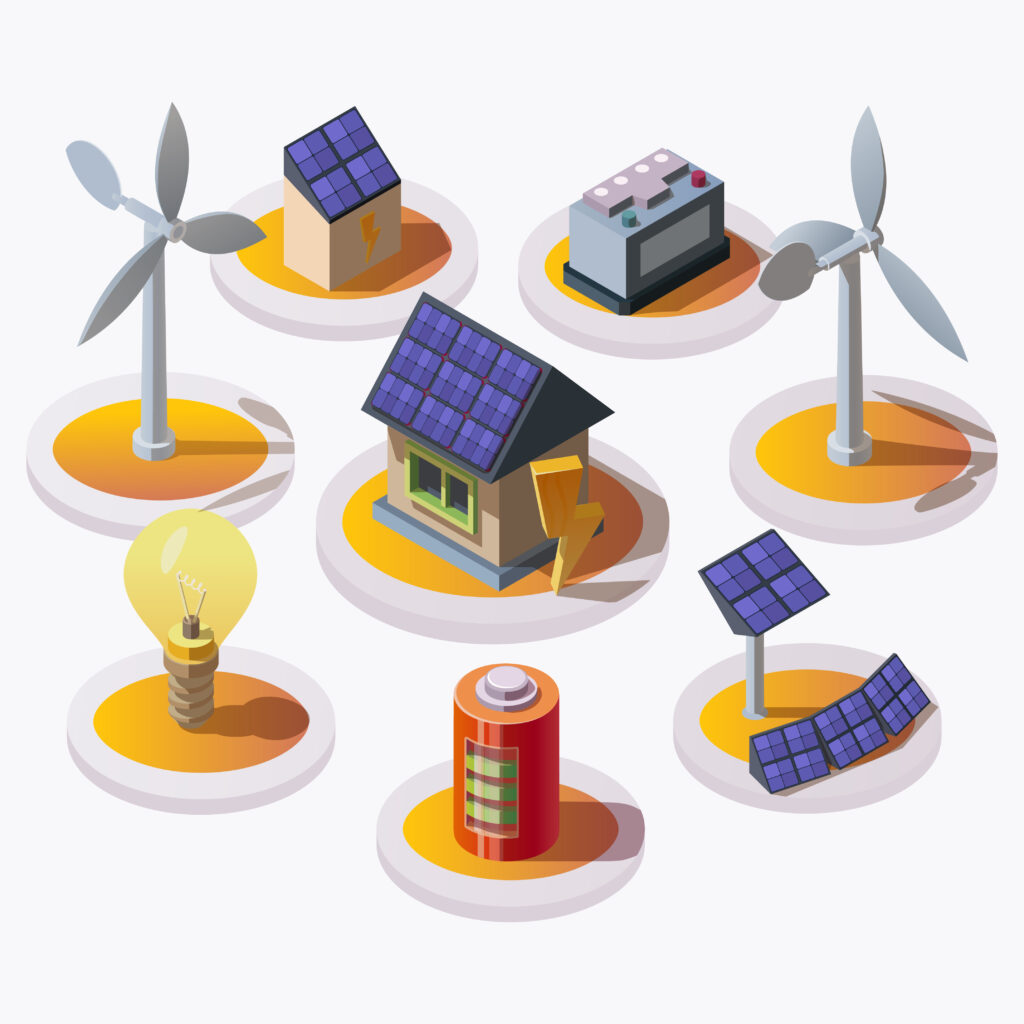
you are truly a just right webmaster The site loading speed is incredible It kind of feels that youre doing any distinctive trick In addition The contents are masterwork you have done a great activity in this matter